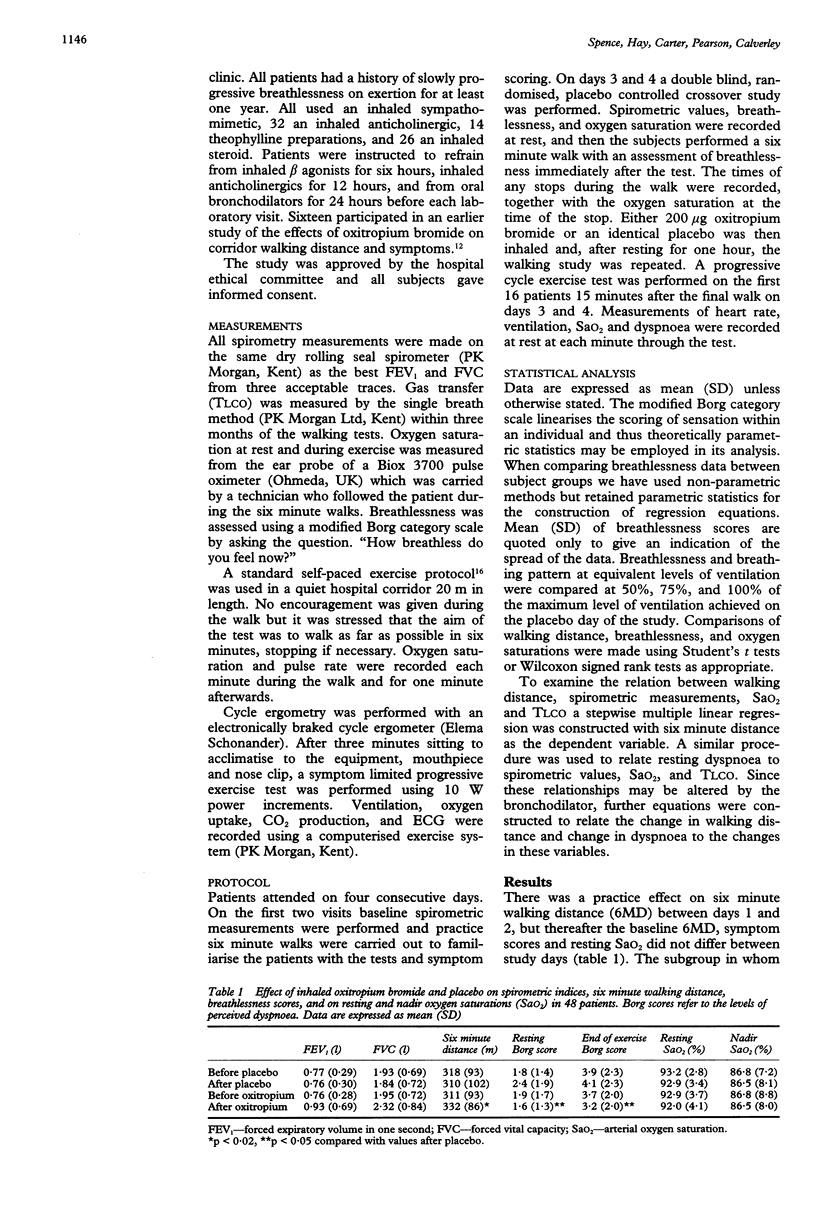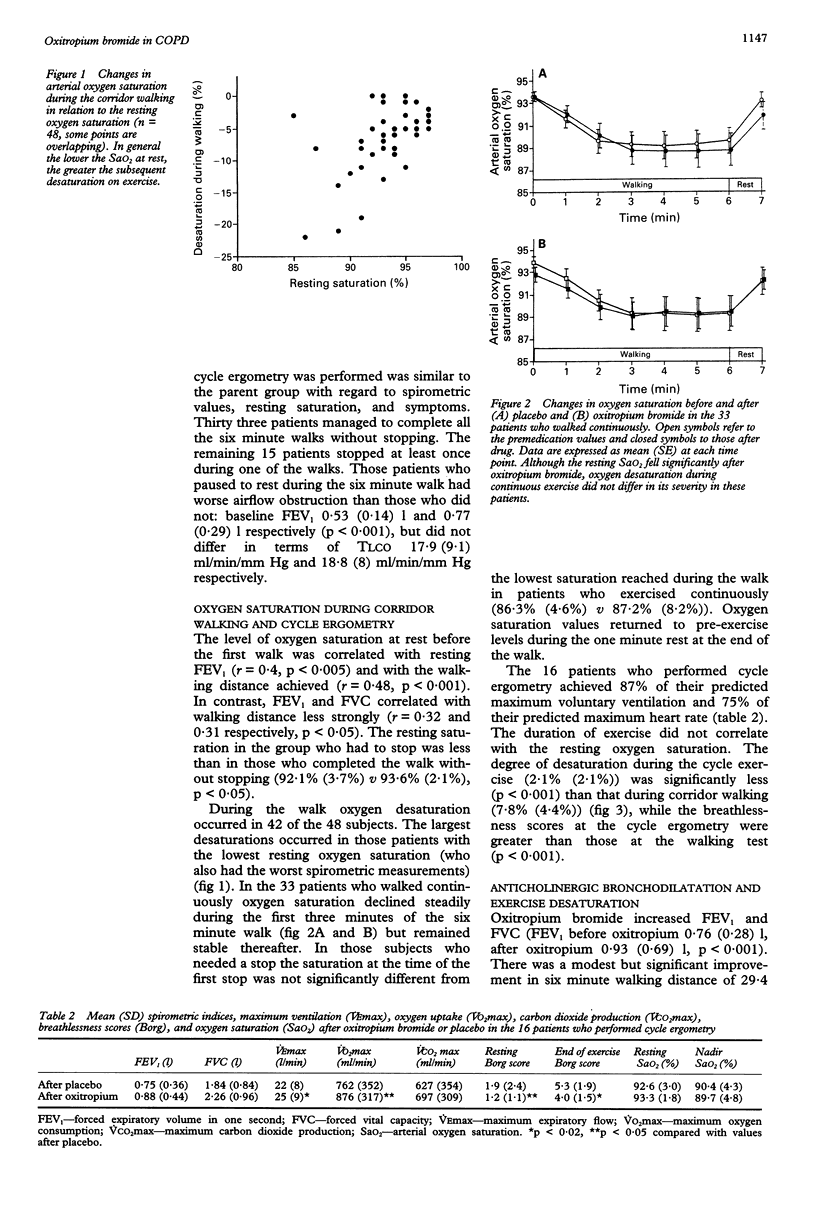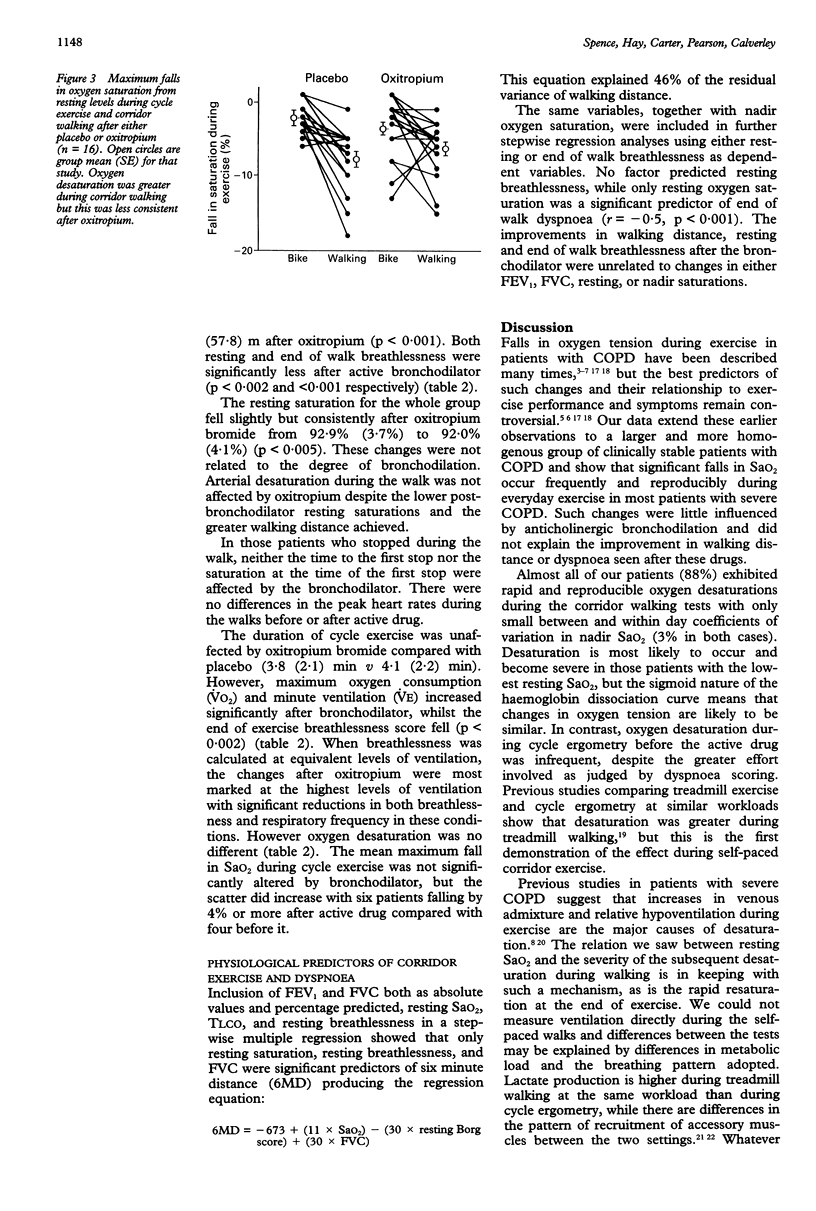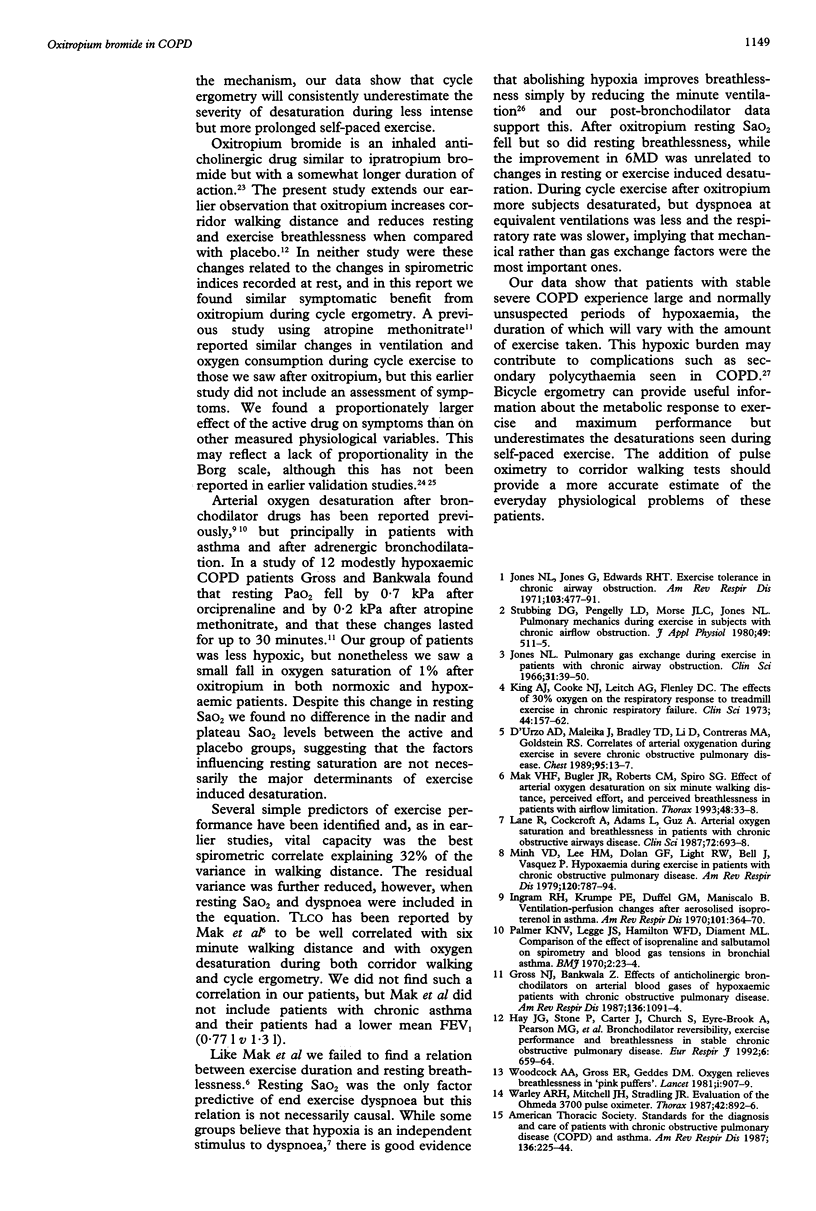Abstract
BACKGROUND--Although exercise induced desaturation can occur in patients with chronic obstructive pulmonary disease (COPD), little is known about its frequency during everyday exercise, or how it relates to dyspnoea or prior drug treatment. METHODS--The effects of 200 micrograms inhaled oxitropium bromide, an anticholinergic bronchodilator drug, on spirometric values, dyspnoea score, and oxygen saturation during corridor walking and cycle ergometry were studied in a double blind, randomised, placebo controlled study. RESULTS--Oxitropium produced a small increase in forced expired volume in one second (FEV1) from 0.76 (0.28) 1 to 0.93 (0.69) 1 and in six minute walking distance from 311 (93) m to 332 (86) m, but did not change progressive cycle exercise duration. Resting and end exercise breathlessness levels were reduced in both forms of exercise after oxitropium. Resting oxygen saturation fell significantly after active bronchodilator from 92.9% (3.7%) to 92.0% (4.1%) but the nadir saturation during exercise was unchanged. The patients desaturated more during corridor walking than cycle ergometry [walking 7.8% (4.4%), cycle ergometry 2.1% (2.1%)]. Baseline walking distance was related to FVC, resting breathlessness and resting oxygen saturation (multiple r2 = 0.46) but only resting saturation correlated with end exercise breathlessness (r2 = -0.25). Improvements in symptoms or exercise performance after oxitropium could not be predicted by changes in spirometric indices or oxygen saturation. CONCLUSIONS--In patients with COPD arterial oxygen desaturation during self-paced walking is common, of greater severity than that during cycle ergometry, but is unaffected by inhaled oxitropium bromide. The factors that predict initial performance are not appropriate markers of functional improvement after an active bronchodilator drug.
Full text
PDF





Selected References
These references are in PubMed. This may not be the complete list of references from this article.
- Butland R. J., Pang J., Gross E. R., Woodcock A. A., Geddes D. M. Two-, six-, and 12-minute walking tests in respiratory disease. Br Med J (Clin Res Ed) 1982 May 29;284(6329):1607–1608. doi: 10.1136/bmj.284.6329.1607. [DOI] [PMC free article] [PubMed] [Google Scholar]
- Calverley P. M., Leggett R. J., McElderry L., Flenley D. C. Cigarette smoking and secondary polycythemia in hypoxic cor pulmonale. Am Rev Respir Dis. 1982 May;125(5):507–510. doi: 10.1164/arrd.1982.125.5.507. [DOI] [PubMed] [Google Scholar]
- Celli B. R., Rassulo J., Make B. J. Dyssynchronous breathing during arm but not leg exercise in patients with chronic airflow obstruction. N Engl J Med. 1986 Jun 5;314(23):1485–1490. doi: 10.1056/NEJM198606053142305. [DOI] [PubMed] [Google Scholar]
- Cockcroft A., Beaumont A., Adams L., Guz A. Arterial oxygen desaturation during treadmill and bicycle exercise in patients with chronic obstructive airways disease. Clin Sci (Lond) 1985 Mar;68(3):327–332. doi: 10.1042/cs0680327. [DOI] [PubMed] [Google Scholar]
- D'Urzo A. D., Mateika J., Bradley D. T., Li D., Contreras M. A., Goldstein R. S. Correlates of arterial oxygenation during exercise in severe chronic obstructive pulmonary disease. Chest. 1989 Jan;95(1):13–17. doi: 10.1378/chest.95.1.13. [DOI] [PubMed] [Google Scholar]
- Dantzker D. R., D'Alonzo G. E. The effect of exercise on pulmonary gas exchange in patients with severe chronic obstructive pulmonary disease. Am Rev Respir Dis. 1986 Dec;134(6):1135–1139. doi: 10.1164/arrd.1986.134.6.1135. [DOI] [PubMed] [Google Scholar]
- Gross N. J., Bankwala Z. Effects of an anticholinergic bronchodilator on arterial blood gases of hypoxemic patients with chronic obstructive pulmonary disease. Comparison with a beta-adrenergic agent. Am Rev Respir Dis. 1987 Nov;136(5):1091–1094. doi: 10.1164/ajrccm/136.5.1091. [DOI] [PubMed] [Google Scholar]
- Hay J. G., Stone P., Carter J., Church S., Eyre-Brook A., Pearson M. G., Woodcock A. A., Calverley P. M. Bronchodilator reversibility, exercise performance and breathlessness in stable chronic obstructive pulmonary disease. Eur Respir J. 1992 Jun;5(6):659–664. [PubMed] [Google Scholar]
- Ingram R. H., Jr, Krumpe P. E., Duffell G. M., Maniscalco B. Ventilation-perfusion changes after aerosolized isoproterenol in asthma. Am Rev Respir Dis. 1970 Mar;101(3):364–370. doi: 10.1164/arrd.1970.101.3.364. [DOI] [PubMed] [Google Scholar]
- Jones N. L., Jones G., Edwards R. H. Exercise tolerance in chronic airway obstruction. Am Rev Respir Dis. 1971 Apr;103(4):477–491. doi: 10.1164/arrd.1971.103.4.477. [DOI] [PubMed] [Google Scholar]
- Jones N. L. Pulmonary gas exchange during exercise in patients with chronic airway obstruction. Clin Sci. 1966 Aug;31(1):39–50. [PubMed] [Google Scholar]
- Lane R., Cockcroft A., Adams L., Guz A. Arterial oxygen saturation and breathlessness in patients with chronic obstructive airways disease. Clin Sci (Lond) 1987 Jun;72(6):693–698. doi: 10.1042/cs0720693. [DOI] [PubMed] [Google Scholar]
- Mak V. H., Bugler J. R., Roberts C. M., Spiro S. G. Effect of arterial oxygen desaturation on six minute walk distance, perceived effort, and perceived breathlessness in patients with airflow limitation. Thorax. 1993 Jan;48(1):33–38. doi: 10.1136/thx.48.1.33. [DOI] [PMC free article] [PubMed] [Google Scholar]
- Martinez F. J., Couser J. I., Celli B. R. Factors influencing ventilatory muscle recruitment in patients with chronic airflow obstruction. Am Rev Respir Dis. 1990 Aug;142(2):276–282. doi: 10.1164/ajrccm/142.2.276. [DOI] [PubMed] [Google Scholar]
- Minh V. D., Lee H. M., Dolan G. F., Light R. W., Bell J., Vasquez P. Hypoxemia during exercise in patients with chronic obstructive pulmonary disease. Am Rev Respir Dis. 1979 Oct;120(4):787–794. doi: 10.1164/arrd.1979.120.4.787. [DOI] [PubMed] [Google Scholar]
- Muza S. R., Silverman M. T., Gilmore G. C., Hellerstein H. K., Kelsen S. G. Comparison of scales used to quantitate the sense of effort to breathe in patients with chronic obstructive pulmonary disease. Am Rev Respir Dis. 1990 Apr;141(4 Pt 1):909–913. doi: 10.1164/ajrccm/141.4_Pt_1.909. [DOI] [PubMed] [Google Scholar]
- Owens G. R., Rogers R. M., Pennock B. E., Levin D. The diffusing capacity as a predictor of arterial oxygen desaturation during exercise in patients with chronic obstructive pulmonary disease. N Engl J Med. 1984 May 10;310(19):1218–1221. doi: 10.1056/NEJM198405103101903. [DOI] [PubMed] [Google Scholar]
- Palmer K. N., Legge J. S., Hamilton W. F., Diament M. L. Comparison of effect of salbutamol and isoprenaline on spirometry and blood-gas tensions in bronchial asthma. Br Med J. 1970 Apr 4;2(5700):23–24. doi: 10.1136/bmj.2.5700.23. [DOI] [PMC free article] [PubMed] [Google Scholar]
- Peel E. T., Anderson G. A dose response study of oxitropium bromide in chronic bronchitis. Thorax. 1984 Jun;39(6):453–456. doi: 10.1136/thx.39.6.453. [DOI] [PMC free article] [PubMed] [Google Scholar]
- Ries A. L., Farrow J. T., Clausen J. L. Pulmonary function tests cannot predict exercise-induced hypoxemia in chronic obstructive pulmonary disease. Chest. 1988 Mar;93(3):454–459. doi: 10.1378/chest.93.3.454. [DOI] [PubMed] [Google Scholar]
- Stubbing D. G., Pengelly L. D., Morse J. L., Jones N. L. Pulmonary mechanics during exercise in subjects with chronic airflow obstruction. J Appl Physiol Respir Environ Exerc Physiol. 1980 Sep;49(3):511–515. doi: 10.1152/jappl.1980.49.3.511. [DOI] [PubMed] [Google Scholar]
- Warley A. R., Mitchell J. H., Stradling J. R. Evaluation of the Ohmeda 3700 pulse oximeter. Thorax. 1987 Nov;42(11):892–896. doi: 10.1136/thx.42.11.892. [DOI] [PMC free article] [PubMed] [Google Scholar]
- Wilson R. C., Jones P. W. A comparison of the visual analogue scale and modified Borg scale for the measurement of dyspnoea during exercise. Clin Sci (Lond) 1989 Mar;76(3):277–282. doi: 10.1042/cs0760277. [DOI] [PubMed] [Google Scholar]
- Woodcock A. A., Gross E. R., Geddes D. M. Oxygen relieves breathlessness in "pink puffers". Lancet. 1981 Apr 25;1(8226):907–909. doi: 10.1016/s0140-6736(81)91612-3. [DOI] [PubMed] [Google Scholar]


